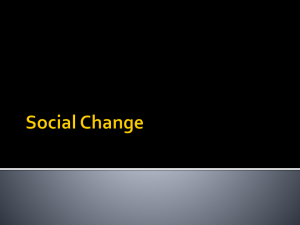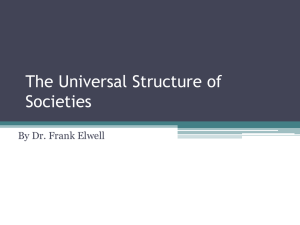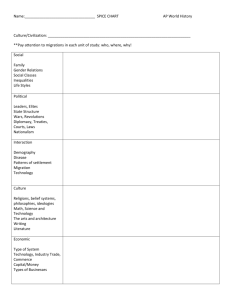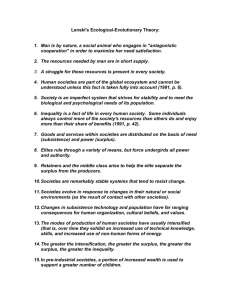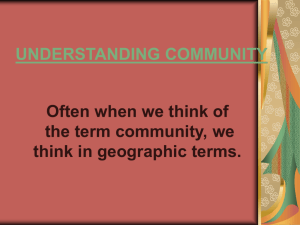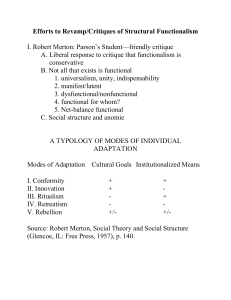CULTURAL ECOLOGY A THEORY
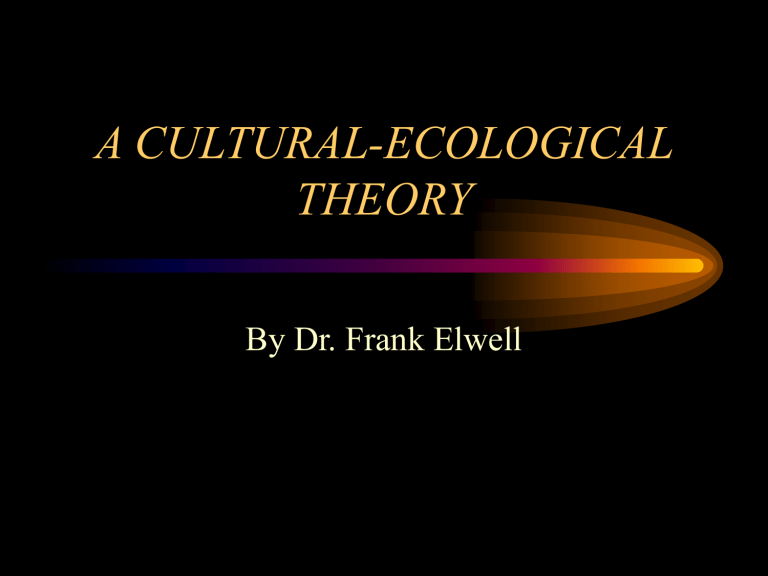
A CULTURAL-ECOLOGICAL
THEORY
By Dr. Frank Elwell
Sociocultural Materialism
•
This course will examine society through the prism of sociocultural materialism.
•
Sociocultural materialism is a theory of sociocultural systems. It is a variant of
Marvin Harris’s cultural Materialism.
Sociocultural Materialism
•
Marvin Harris, a cultural anthropologist, is responsible for the most systematic statement of C.M. principles.
•
A theory is simply a world view-- a framework for understanding your world and organizing observations. Points at what to look for.
Sociocultural Materialism
•
It is a theory that attempts to account for sociocultural:
– origins
– maintenance
– change
Assumptions:
•
The various parts of society are interrelated.
When one part of society changes, other parts must also change. An institution, such as the family cannot be looked at in isolation from the economic, political, or religious institutions of a society.
•
When one part changes it has an effect on other parts of the system.
Assumptions:
Environmental base to human societies
Assumptions:
Viewing society as a system of interrelated parts is at the core of most social theory.
Difference is in terms of organizing principles. The way a society is organized to meet the needs of its population determines the rest of the system.
•
Mankind is relatively free from biological instincts, drives and predispositions.
•
Rather than relying on instincts, most human behavior is learned. To say it is learned does not mean that it is not deep.
Eating slugs for example.
Human Needs
BIO-PSYCHOLOGICAL NEEDS
•
Eat
•
Energy conservation
•
Love
•
Sex
•
Meaning
•
People need to eat and will generally opt for diets that offer more rather than fewer calories and proteins and other nutrients.
• American's have carried this to a high art. Now we diet--but it is a discipline.
Need to Eat
Energy Conservation
•
People cannot be totally inactive, but when confronted with a given task, they prefer to carry it out by expending less rather than more human energy.
•
American's have carried this to a high art.
How many took elevator? Exercise is a discipline.
Need for Sex
•
People are highly sexed and generally find reinforcing pleasure from sexual intercourse.
•
We learn proper (or improper) object of sex.
Pygmy chimpanzees and lions.
•
People need love and affection in order to feel secure and happy, and other things being equal, they will act to increase the love and affection other give them.
•
Without love, human infants fail to thrive. Can die. With minimal love we warp.
Need for Love
Need for Meaning
•
People need meaning in their lives. This need arises out of our capacity for self awareness.
•
Implied in Harris. Sometimes this need is fulfilled through religion, sometimes philosophy, sometimes entire culture try to give meaning to lives.
Bio-psychological Needs
•
The entire socio-cultural system rests on the way society exploits its environment to meet the bio-psychological needs of its population.
Bio-psychological Needs
While the needs are universal, the ways in which societies meet these needs as well as the extent to which these needs are met are highly variable.
Bio-psychological Needs
•
Some societies approve of eating worms, homosexuality, wife sharing, gods, etc.
•
There are other needs, but parsimony takes precedence. All needs are shared with other primates (save meaning).
Environment
•
The physical, biological, and chemical constraints to which human action is subject.
•
Like all living organisms, Humans must draw energy from their environment.
Environment
The environment is limited in terms of the amount of energy and matter it contains, and the amount of pollution it can tolerate.
Environment
•
Therefore, each society must ultimately exist within the constraints imposed by its environment.
•
The need to draw energy out of the environment in order to satisfy the biopsychological needs of its people is the first and central task of any society.
Environmental Constraints
•
Chief among these constraints is the availability of natural resources.
•
A further constraining factor is the amount of pollution created by society. While man can modify these constraints, they cannot be escaped.
Infrastructure
•
The principal interface between a socio-cultural system and its environment.
•
It is through the infrastructure that society manipulates its environment by modifying the amount and type of resources needed.
Infrastructure
•
Consists of two parts, the mode of production and reproduction.
•
The modes of production and reproduction are attempts to strike a balance between population and the consumption of energy from a finite environment.
Mode of Production
•
Consists of behaviors aimed at satisfying requirements for subsistence.
–
Technology of subsistence
–
Technological-environmental relationships
Modes of Production through
History
•
The mode of production is the way most anthropologists and sociologists classify society.
•
This is because it is generally recognized as one of the most powerful determinants of the rest of the sociocultural system
Modes of Production through
History
•
Hunting and Gathering
•
Horticulture
•
Pastoral
•
Agrarian
•
Industrial
Mode of Reproduction
Consisting of behaviors aimed at controlling destructive increases or decreases in population size. Suppose we are a hunting and gathering society and we are running out of food. What can we do? It is upon this environmental infrastructural foundation that the remaining parts of the social system are based.
Mode of Reproduction
•
Demography
•
Mating patterns
•
Fertility, natality, mortality
•
Nurturance of infants
•
Medicine
•
Contraception, abortion, infanticide
Social Structure
•
Social structure refers to human groups and organizations.
•
Two types:
– primary
– secondary
Social Structure
Primary groups consist of small groups like the family that regulate reproduction, exchange and consumption within domestic settings.
Normally small, intimate, multiple roles.
Primary Groups
• family
• community
• some voluntary groups
• friendship networks
• some religious groups
Primary Groups
SECONDARY ORGANIZATIONS
Impersonal organizations such as government and industry which regulate productions, exchange and consumption within and between groups and socio-cultural systems.
SECONDARY ORGANIZATIONS
•
Governments, military, police
•
Corporations
•
Education
•
Media
•
Service and professional organizations
•
Welfare organizations
Bureaucratization
•
Curious phenomenon: over the course of social evolution, primary groups lose their function, secondary groups grow in number.
•
Increasing division of labor. The primary and secondary groups dichotomy encompasses all human organizations responsible for the allocation and distribution of all bio-psychological need satisfaction.
Elites
Hierarchies based on class, sex, race, caste, age, ethnic, and other statuses exist throughout the structure of society.
Elites
•
All societies have elites, but the power of elites varies across societies and through time.
•
The bio-psychological satisfaction of those on top of the hierarchies weighs more heavily than those below.
•
Consists of two parts:
– cultural superstructure
– mental superstructure
Superstructure
Cultural Superstructure
•
Includes recreations activities, art, sports, empirical knowledge, folklore, and other aesthetic products.
–
Art, music, dance, literature
–
Rituals
– sports, games, hobbies
– knowledge base
•
Values
•
Emotions
•
Traditions
•
Zweckrational
Mental Superstructure
Mental Superstructure
•
This is from Max Weber. He said there were four basic motivators for human behavior.
•
Ideal types. Actual behavior motivated by combinations.
Value oriented behavior
•
Rational action in relation to a value.
•
Examples: Attending college because you value the life of the mind. Doing the right thing out of religious or philosophical ideas of right or wrong.
Affective behavior
•
Affective or emotional action.
•
Examples: Anger or joy. Serves no rational purpose, expresses feelings. Attending college for a good time, or because your significant other attends.
Traditional behavior
•
Action dictated by custom or habit.
•
Examples: Sign of the cross. Facing front in an elevator, not talking at movies.
Attending college because your mother attended.
Zweckrational guided behavior
•
Rational action in relation to a goal.
•
Examples: Building a raft to cross a river.
Studying to get a good grade. Attending college to get a good job.
Mental Superstructure
Weber noticed a curious phenomenon:
Zweckrational increasingly dominates.
Infrastructural Determinism
•
The major principle of sociocultural materialism:
– The mode of production and reproduction determine primary and secondary group structure, which in turn determine the cultural and mental superstructure.
Infrastructural Determinism
The rationale behind giving the infrastructure such priority rests upon the fact that it is through infrastructural practices that society adapts to its environment.
Infrastructural Determinism
It is through the infrastructure that society survives. It modifies the amount and type of resources required for life. Since these infrastructural practices are essential for life itself, all widespread structural and superstructural patterns must be compatible with them.
Intensification
•
World population and industrial infrastructures are growing at an exponential rate.
•
You can't do one thing. This growth (or intensification) has impact on other parts of the system.
Bureaucratization
The intensification of the infrastructure causes the growth of secondary organizations at the expense of primary groups.
Rationalization
The intensification of the infrastructure and the bureaucratization of the structure, cause the superstructure to "rationalize."
Rationalization
Definition: the increasing dominance of goal oriented rational behavior at the expense of behavior guided by values, traditions and emotions
Feedback Loops:
While the infrastructure is considered to be of primary importance, the structure and superstructure are not mere reflections of infrastructural processes, but are in interaction with these processes.
Feedback Loops:
•
Societies are very stable systems. The most likely outcome of any change in the system is resistance in other sectors of society.
•
This "system maintaining negative feedback" is capable of deflecting, dampening, or extinguishing most system change.
Feedback Loops:
•
The result is either the extinctions of the innovation or slight compensatory changes that preserve the fundamental character of the whole system.
• Examples: income tax, women’s liberation, commune movement.
Feedback Loops:
In general, socio-cultural change that releases more energy from the environment is likely to be swiftly adapted.
Feedback Loops:
•
Infrastructural and environmental relationships are central in explaining sociocultural change.
•
But we also recognize the importance of structures and superstructures in determining the speed, and character of change.
But it is not the simple calculation of the greatest good for the greatest number of people to account for socio-cultural change.
Many changes are more satisfying to some members of society than to others.
The role of elites
The role of elites
Infrastructural change that enhance the position of these elites are likely to be amplified and propagated throughout the system. The elites are able to impose direct economic and political sanctions to get their way. Also encourage ideas and ideologies favorable to their position.
The role of elites
•
Sociocultural materialism is in fundamental agreement with Marx when he states:
"The ideas of the ruling class in each epoch are the ruling ideas."
•
The amount of power and control exercised by elites varies across societies and through time.
The role of elites in the U.S.
•
In the U.S. the power of elites has waxed and waned.
•
They are probably more powerful in the last half of the 19th century than they are today.
•
Some claim they are in the process of reasserting their power.
The role of elites
There exists within every society a dominant class (or classes) that possess a disproportionate amount of social power.
The role of elites
A sociocultural materialist analysis attempts to identify this class, gauge the amount of power it wields, and uncover their biases and assumptions when analyzing social systems.


